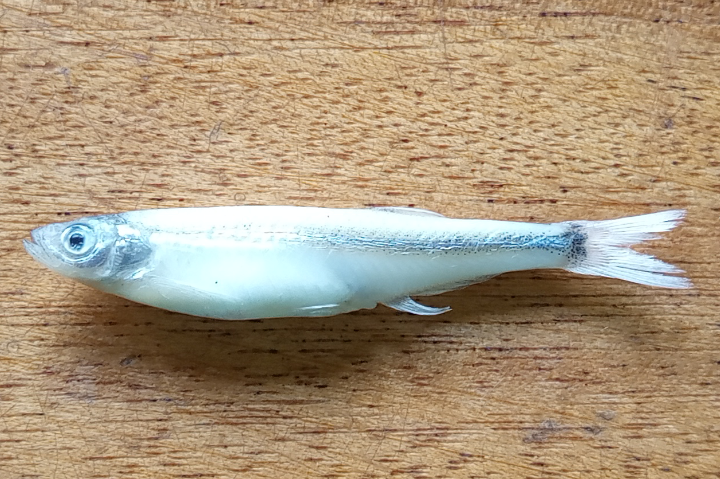Common names:
Unknown
None
Taxonomic tree
Kingdom: Animalia
Phylum: Chordata
Class: Actinopterygii (ray-finned fish)
Order: Cypriniformes (Carps)
Family: Danionidae (Danios)
Genus: Engraulicypris
Species: Engraulicypris bredoi (Poll 1945)
Number of Occurrancies: 40
Etymology(based on Sharpf & Lazara 2019)
- Engraulicypris: engraulis, anchovy, referring to anchovy-like shape and coloration (and presumably its shoaling and zooplanktivory as well); cypris, a small carp, a common suffix for cyprinoid genera
- bredoi: in honor of Belgian explorer Hans J. Brédo (1903-1991), who collected type
Synonyms: click here to view synonym
Type locality: Lake Albert, Kasenyi. Holotype at Musée royal de l'Afrique centrale (MRAC)
Distinguishing characters for the genus
- lateral line situated below the middle of flank and caudal peduncal, and a cheek below the eye covered by thin sub-orbital bones (vs. Labeo, Labeobarbus, Garra, and Enteromius: lateral line runs along middle of the flank and the caudal peduncle; no sub-orbital bones on the cheek).
- Almost the entire dorsal fin situated above the anal fin (vs. Leptocypris: greater part of the dorsal fin is situated in advance of the anal fin)
Distinguishing characters for species
- 10 or 11 gill rakers on the lower part of the first arch (distinction from Rastrineobola argentea with 16 gill rakers)
- Lateral line with 36-39 complete scales (distinction from R. argentea with 48-52 scales)
- Dorsal fin with II-III, 7 or 8 rays, its origin above of the anal which has II-III, 11-13 branched rays (distinction from R. argentea with 14-17 anal fin rays)
- Depth of body contained 4-5 times in standard length, length of the head 3.75-4.25 times
- Snout pointed, somewhat shorter than the eye which is contained 3.5-4 times in head length
- A large terminal mouth, extending to below the anterior border of the eye
- Colour is intensely silver, surface of head darker. A dark mid-lateral stripe appears after death.
Taxonomic remarks: This species resembles R. argentea, but differs on the number of lateral line scales, gill rakers on the first arch, and fewer anal fin rays.
Distribution in Uganda: Endemic to Lake ALbert
Occurence: Endemic
Habitat: Benthopelagic; common in surface zone of inshore waters
Feeding: Unknown
Biology: No available information
Economic importance/End use: The species is of great commercial value around Lake Albert. Available data shows that by 2012, about 78,000 tonnes of the species were harvested per year worth $11.4 million (Mbabazi et al., 2012). The species is used both for human consumption and in animal feeds.
IUCN conservation status: Not Evaluated
Threats: Overfishing due to the increasing demand from animal feed industry
Main references
- Greenwood PH. 1966. The fishes of Uganda. The Uganda Society, Kampala. 131 pages.
- Sharpf C, Lazara J.K. 2019. Fish Name Etymology Database v4. www.etyfish.org
- Mbabazi D, Taabu-Munyaho M, Muhoozi L.I, Nakiyende H, Bassa S, Muhumuza E, Amiina R, Balirwa J. 2012. The past, present and projected scenarios in the Lake Albert and Albert Nile fisheries: Implications for sustainable management. Uganda Journal of Agricultural Sciences, 13 (2): 47-64.

